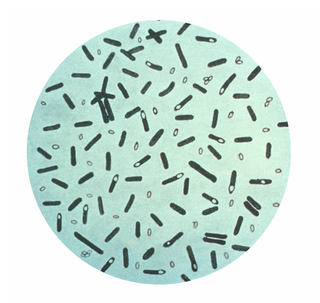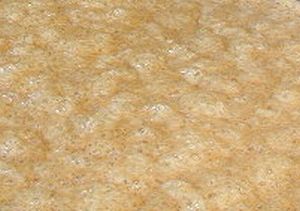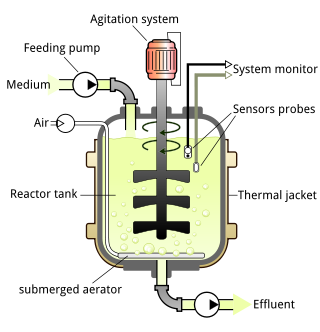
Botulism is a rare and potentially fatal illness caused by a toxin produced by the bacterium Clostridium botulinum. The disease begins with weakness, blurred vision, feeling tired, and trouble speaking. This may then be followed by weakness of the arms, chest muscles, and legs. Vomiting, swelling of the abdomen, and diarrhea may also occur. The disease does not usually affect consciousness or cause a fever.

An endospore is a dormant, tough, and non-reproductive structure produced by some bacteria in the phylum Bacillota. The name "endospore" is suggestive of a spore or seed-like form, but it is not a true spore. It is a stripped-down, dormant form to which the bacterium can reduce itself. Endospore formation is usually triggered by a lack of nutrients, and usually occurs in gram-positive bacteria. In endospore formation, the bacterium divides within its cell wall, and one side then engulfs the other. Endospores enable bacteria to lie dormant for extended periods, even centuries. There are many reports of spores remaining viable over 10,000 years, and revival of spores millions of years old has been claimed. There is one report of viable spores of Bacillus marismortui in salt crystals approximately 25 million years old. When the environment becomes more favorable, the endospore can reactivate itself into a vegetative state. Most types of bacteria cannot change to the endospore form. Examples of bacterial species that can form endospores include Bacillus cereus, Bacillus anthracis, Bacillus thuringiensis, Clostridium botulinum, and Clostridium tetani. Endospore formation is not found among Archaea.

Clostridium botulinum is a gram-positive, rod-shaped, anaerobic, spore-forming, motile bacterium with the ability to produce botulinum toxin, which is a neurotoxin.

Cottage cheese is a curdled milk product with a mild flavour and a creamy, heterogeneous, soupy texture, made from skimmed milk. An essential step in the manufacturing process distinguishing cottage cheese from other fresh cheeses is the addition of a "dressing" to the curd grains, usually cream, which is mainly responsible for the taste of the product. Cottage cheese is not aged.

Butyric acid, also known under the systematic name butanoic acid, is a straight-chain alkyl carboxylic acid with the chemical formula CH3CH2CH2CO2H. It is an oily, colorless liquid with an unpleasant odor. Isobutyric acid is an isomer. Salts and esters of butyric acid are known as butyrates or butanoates. The acid does not occur widely in nature, but its esters are widespread. It is a common industrial chemical and an important component in the mammalian gut.

Silage is fodder made from green foliage crops which have been preserved by fermentation to the point of souring. It is fed to cattle, sheep and other ruminants. The fermentation and storage process is called ensilage, ensiling, or silaging. The exact methods vary, depending on available technology, local tradition and prevailing climate.

Clostridium is a genus of anaerobic, Gram-positive bacteria. Species of Clostridium inhabit soils and the intestinal tract of animals, including humans. This genus includes several significant human pathogens, including the causative agents of botulism and tetanus. It also formerly included an important cause of diarrhea, Clostridioides difficile, which was reclassified into the Clostridioides genus in 2016.

Camembert is a moist, soft, creamy, surface-ripened cow's milk cheese. It was first made in the late 18th century in Camembert, Normandy, in northwest France. It is sometimes compared in look and taste to brie cheese, albeit with a slightly lower butterfat content than brie's typical 20% – 25% by weight.

Clostridium perfringens is a Gram-positive, bacillus (rod-shaped), anaerobic, spore-forming pathogenic bacterium of the genus Clostridium. C. perfringens is ever-present in nature and can be found as a normal component of decaying vegetation, marine sediment, the intestinal tract of humans and other vertebrates, insects, and soil. It has the shortest reported generation time of any organism at 6.3 minutes in thioglycolate medium.

Cheesemaking is the craft of making cheese. The production of cheese, like many other food preservation processes, allows the nutritional and economic value of a food material, in this case milk, to be preserved in concentrated form. Cheesemaking allows the production of the cheese with diverse flavors and consistencies.

Blue cheese is any of a wide range of cheeses made with the addition of cultures of edible molds, which create blue-green spots or veins through the cheese. Blue cheeses vary in taste from very mild to strong, and from slightly sweet to salty or sharp; in colour from pale to dark; and in consistency from liquid to hard. They may have a distinctive smell, either from the mold or from various specially cultivated bacteria such as Brevibacterium linens.

1-Butanol, also known as butan-1-ol or n-butanol, is a primary alcohol with the chemical formula C4H9OH and a linear structure. Isomers of 1-butanol are isobutanol, butan-2-ol and tert-butanol. The unmodified term butanol usually refers to the straight chain isomer.

Fermentation is a metabolic process that produces chemical changes in organic substances through the action of enzymes. In biochemistry, fermentation is narrowly defined as the extraction of energy from carbohydrates in the absence of oxygen, while in food production, it may more broadly refer to any process in which the activity of microorganisms brings about a desirable change to a foodstuff or beverage. The science of fermentation is known as zymology.

In food processing, fermentation is the conversion of carbohydrates to alcohol or organic acids using microorganisms—yeasts or bacteria—under anaerobic (oxygen-free) conditions. Fermentation usually implies that the action of microorganisms is desired. The science of fermentation is known as zymology or zymurgy.

Food microbiology is the study of the microorganisms that inhabit, create, or contaminate food. This includes the study of microorganisms causing food spoilage; pathogens that may cause disease ; microbes used to produce fermented foods such as cheese, yogurt, bread, beer, and wine; and microbes with other useful roles, such as producing probiotics.

Clostridium septicum is a gram positive, spore forming, obligate anaerobic bacterium.

Clostridium butyricum is a strictly anaerobic endospore-forming Gram-positive butyric acid–producing bacillus subsisting by means of fermentation using an intracellularly accumulated amylopectin-like α-polyglucan (granulose) as a substrate. It is uncommonly reported as a human pathogen and is widely used as a probiotic in Japan, Korea, and China. C. butyricum is a soil inhabitant in various parts of the world, has been cultured from the stool of healthy children and adults, and is common in soured milk and cheeses. The connection with dairy products is shown by the name, the butyr- in butyricum reflects the relevance of butyric acid in the bacteria's metabolism and the connection with Latin butyrum and Greek βούτυρον, with word roots pertaining to butter and cheese.
Hathewaya histolytica is a species of bacteria found in feces and the soil. It is a motile, gram-positive, aerotolerant anaerobe. H. histolytica is pathogenic in many species, including guinea pigs, mice, and rabbits, and humans. H. histolytica has been shown to cause gas gangrene, often in association with other bacteria species.

Industrial microbiology is a branch of biotechnology that applies microbial sciences to create industrial products in mass quantities, often using microbial cell factories. There are multiple ways to manipulate a microorganism in order to increase maximum product yields. Introduction of mutations into an organism may be accomplished by introducing them to mutagens. Another way to increase production is by gene amplification, this is done by the use of plasmids, and vectors. The plasmids and/ or vectors are used to incorporate multiple copies of a specific gene that would allow more enzymes to be produced that eventually cause more product yield. The manipulation of organisms in order to yield a specific product has many applications to the real world like the production of some antibiotics, vitamins, enzymes, amino acids, solvents, alcohol and daily products. Microorganisms play a big role in the industry, with multiple ways to be used. Medicinally, microbes can be used for creating antibiotics in order to treat infection. Microbes can also be used for the food industry as well. Microbes are very useful in creating some of the mass produced products that are consumed by people. The chemical industry also uses microorganisms in order to synthesize amino acids and organic solvents. Microbes can also be used in an agricultural application for use as a biopesticide instead of using dangerous chemicals and or inoculants to help plant proliferation.
A beerfault or defect is a flavour deterioration caused by chemical changes of organic compounds in beer due to either improper production processes or improper storage. Chemicals that can cause flavour defects in beer are aldehydes, lipids, and sulfur compounds. Small fluctuations within fermentation byproducts can lead to the concentration of one or more of these chemicals falling outside a standard range, creating a flavour defect. It is also possible that during the malting process, microbial deterioration may occur, which leads to the loss of beer flavor.
















